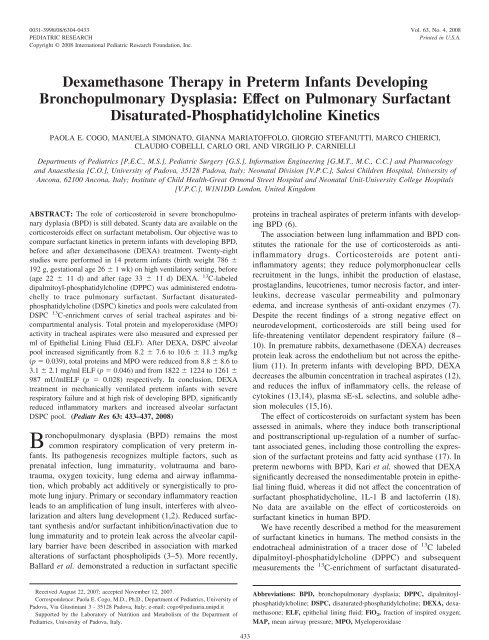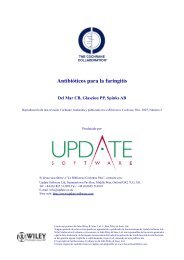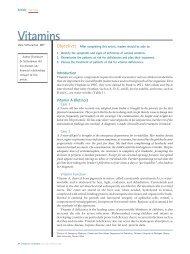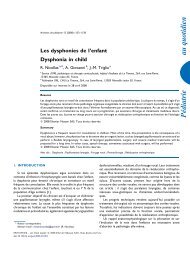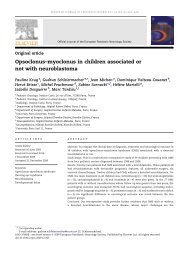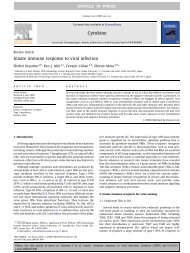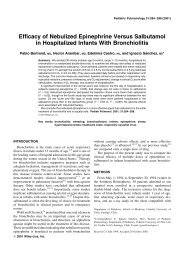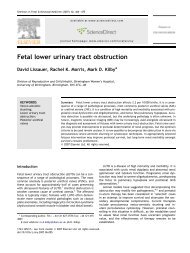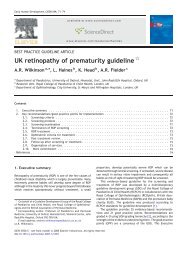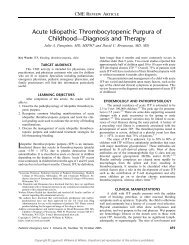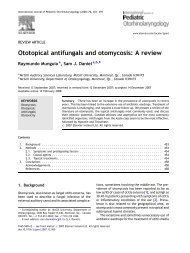Dexamethasone Therapy in Preterm Infants Developing ... - sepeap
Dexamethasone Therapy in Preterm Infants Developing ... - sepeap
Dexamethasone Therapy in Preterm Infants Developing ... - sepeap
Create successful ePaper yourself
Turn your PDF publications into a flip-book with our unique Google optimized e-Paper software.
433<br />
0031-3998/08/6304-0433<br />
PEDIATRIC RESEARCH<br />
Copyright © 2008 International Pediatric Research Foundation, Inc.<br />
Vol. 63, No. 4, 2008<br />
Pr<strong>in</strong>ted <strong>in</strong> U.S.A.<br />
<strong>Dexamethasone</strong> <strong>Therapy</strong> <strong>in</strong> <strong>Preterm</strong> <strong>Infants</strong> Develop<strong>in</strong>g<br />
Bronchopulmonary Dysplasia: Effect on Pulmonary Surfactant<br />
Disaturated-Phosphatidylchol<strong>in</strong>e K<strong>in</strong>etics<br />
PAOLA E. COGO, MANUELA SIMONATO, GIANNA MARIATOFFOLO, GIORGIO STEFANUTTI, MARCO CHIERICI,<br />
CLAUDIO COBELLI, CARLO ORI, AND VIRGILIO P. CARNIELLI<br />
Departments of Pediatrics [P.E.C., M.S.], Pediatric Surgery [G.S.], Information Eng<strong>in</strong>eer<strong>in</strong>g [G.M.T., M.C., C.C.] and Pharmacology<br />
and Anaesthesia [C.O.], University of Padova, 35128 Padova, Italy; Neonatal Division [V.P.C.], Salesi Children Hospital, University of<br />
Ancona, 62100 Ancona, Italy; Institute of Child Health-Great Ormond Street Hospital and Neonatal Unit-University College Hospitals<br />
[V.P.C.], W1N1DD London, United K<strong>in</strong>gdom<br />
ABSTRACT: The role of corticosteroid <strong>in</strong> severe bronchopulmonary<br />
dyplasia (BPD) is still debated. Scanty data are available on the<br />
corticosteroids effect on surfactant metabolism. Our objective was to<br />
compare surfactant k<strong>in</strong>etics <strong>in</strong> preterm <strong>in</strong>fants with develop<strong>in</strong>g BPD,<br />
before and after dexamethasone (DEXA) treatment. Twenty-eight<br />
studies were performed <strong>in</strong> 14 preterm <strong>in</strong>fants (birth weight 786 <br />
192 g, gestational age 26 1 wk) on high ventilatory sett<strong>in</strong>g, before<br />
(age 22 11 d) and after (age 33 11 d) DEXA. 13 C-labeled<br />
dipalmitoyl-phosphatidylchol<strong>in</strong>e (DPPC) was adm<strong>in</strong>istered endotrachelly<br />
to trace pulmonary surfactant. Surfactant disaturatedphosphatidylchol<strong>in</strong>e<br />
(DSPC) k<strong>in</strong>etics and pools were calculated from<br />
DSPC 13 C-enrichment curves of serial tracheal aspirates and bicompartmental<br />
analysis. Total prote<strong>in</strong> and myeloperoxidase (MPO)<br />
activity <strong>in</strong> tracheal aspirates were also measured and expressed per<br />
ml of Epithelial L<strong>in</strong><strong>in</strong>g Fluid (ELF). After DEXA, DSPC alveolar<br />
pool <strong>in</strong>creased significantly from 8.2 7.6 to 10.6 11.3 mg/kg<br />
(p 0.039), total prote<strong>in</strong>s and MPO were reduced from 8.8 8.6 to<br />
3.1 2.1 mg/ml ELF (p 0.046) and from 1822 1224 to 1261 <br />
987 mU/mlELF (p 0.028) respectively. In conclusion, DEXA<br />
treatment <strong>in</strong> mechanically ventilated preterm <strong>in</strong>fants with severe<br />
respiratory failure and at high risk of develop<strong>in</strong>g BPD, significantly<br />
reduced <strong>in</strong>flammatory markers and <strong>in</strong>creased alveolar surfactant<br />
DSPC pool. (Pediatr Res 63: 433–437, 2008)<br />
Bronchopulmonary dysplasia (BPD) rema<strong>in</strong>s the most<br />
common respiratory complication of very preterm <strong>in</strong>fants.<br />
Its pathogenesis recognizes multiple factors, such as<br />
prenatal <strong>in</strong>fection, lung immaturity, volutrauma and barotrauma,<br />
oxygen toxicity, lung edema and airway <strong>in</strong>flammation,<br />
which probably act additively or synergistically to promote<br />
lung <strong>in</strong>jury. Primary or secondary <strong>in</strong>flammatory reaction<br />
leads to an amplification of lung <strong>in</strong>sult, <strong>in</strong>terferes with alveolarization<br />
and alters lung development (1,2). Reduced surfactant<br />
synthesis and/or surfactant <strong>in</strong>hibition/<strong>in</strong>activation due to<br />
lung immaturity and to prote<strong>in</strong> leak across the alveolar capillary<br />
barrier have been described <strong>in</strong> association with marked<br />
alterations of surfactant phospholipids (3–5). More recently,<br />
Ballard et al. demonstrated a reduction <strong>in</strong> surfactant specific<br />
prote<strong>in</strong>s <strong>in</strong> tracheal aspirates of preterm <strong>in</strong>fants with develop<strong>in</strong>g<br />
BPD (6).<br />
The association between lung <strong>in</strong>flammation and BPD constitutes<br />
the rationale for the use of corticosteroids as anti<strong>in</strong>flammatory<br />
drugs. Corticosteroids are potent anti<strong>in</strong>flammatory<br />
agents; they reduce polymorphonuclear cells<br />
recruitment <strong>in</strong> the lungs, <strong>in</strong>hibit the production of elastase,<br />
prostagland<strong>in</strong>s, leucotrienes, tumor necrosis factor, and <strong>in</strong>terleuk<strong>in</strong>s,<br />
decrease vascular permeability and pulmonary<br />
edema, and <strong>in</strong>crease synthesis of anti-oxidant enzymes (7).<br />
Despite the recent f<strong>in</strong>d<strong>in</strong>gs of a strong negative effect on<br />
neurodevelopment, corticosteroids are still be<strong>in</strong>g used for<br />
life-threaten<strong>in</strong>g ventilator dependent respiratory failure (8–<br />
10). In premature rabbits, dexamethasone (DEXA) decreases<br />
prote<strong>in</strong> leak across the endothelium but not across the epithelium<br />
(11). In preterm <strong>in</strong>fants with develop<strong>in</strong>g BPD, DEXA<br />
decreases the album<strong>in</strong> concentration <strong>in</strong> tracheal aspirates (12),<br />
and reduces the <strong>in</strong>flux of <strong>in</strong>flammatory cells, the release of<br />
cytok<strong>in</strong>es (13,14), plasma sE-sL select<strong>in</strong>s, and soluble adhesion<br />
molecules (15,16).<br />
The effect of corticosteroids on surfactant system has been<br />
assessed <strong>in</strong> animals, where they <strong>in</strong>duce both transcriptional<br />
and posttranscriptional up-regulation of a number of surfactant<br />
associated genes, <strong>in</strong>clud<strong>in</strong>g those controll<strong>in</strong>g the expression<br />
of the surfactant prote<strong>in</strong>s and fatty acid synthase (17). In<br />
preterm newborns with BPD, Kari et al. showed that DEXA<br />
significantly decreased the nonsedimentable prote<strong>in</strong> <strong>in</strong> epithelial<br />
l<strong>in</strong><strong>in</strong>g fluid, whereas it did not affect the concentration of<br />
surfactant phosphatidychol<strong>in</strong>e, 1L-1 and lactoferr<strong>in</strong> (18).<br />
No data are available on the effect of corticosteroids on<br />
surfactant k<strong>in</strong>etics <strong>in</strong> human BPD.<br />
We have recently described a method for the measurement<br />
of surfactant k<strong>in</strong>etics <strong>in</strong> humans. The method consists <strong>in</strong> the<br />
endotracheal adm<strong>in</strong>istration of a tracer dose of 13 C labeled<br />
dipalmitoyl-phosphatidylchol<strong>in</strong>e (DPPC) and subsequent<br />
measurements the 13 C-enrichment of surfactant disaturated-<br />
Received August 22, 2007; accepted November 12, 2007.<br />
Correspondence: Paola E. Cogo, M.D., Ph.D., Department of Pediatrics, University of<br />
Padova, Via Giust<strong>in</strong>iani 3 - 35128 Padova, Italy; e-mail: cogo@pediatria.unipd.it<br />
Supported by the Laboratory of Nutrition and Metabolism of the Department of<br />
Pediatrics, University of Padova, Italy.<br />
Abbreviations: BPD, bronchopulmonary dysplasia; DPPC, dipalmitoylphosphatidylchol<strong>in</strong>e;<br />
DSPC, disaturated-phosphatidylchol<strong>in</strong>e; DEXA, dexamethasone;<br />
ELF, epithelial l<strong>in</strong><strong>in</strong>g fluid; FiO 2 , fraction of <strong>in</strong>spired oxygen;<br />
MAP, mean airway pressure; MPO, Myeloperoxidase
434 COGO ET AL.<br />
phosphatidylchol<strong>in</strong>e (DSPC) from serial tracheal aspirates<br />
(19). Based on the assumptions that the tracer is distributed<br />
between the alveolar and lung tissue pools, a bicompartmental<br />
analysis of the tracer to tracee ratio allows the estimation of<br />
the alveolar and lung tissue DSPC pools and of DSPC synthesis<br />
and fluxes between the two pools (20).<br />
In this study, we compared the effect of a 10-day taper<strong>in</strong>g<br />
dose of DEXA on surfactant DSPC k<strong>in</strong>etics <strong>in</strong> preterm <strong>in</strong>fants<br />
with develop<strong>in</strong>g BPD.<br />
MATERIALS AND METHODS<br />
Patients. Patients were admitted to the Neonatal Intensive Care, Department<br />
of Pediatrics, University of Padua, Italy, from 1999 to 2002. The study<br />
was approved by the local Research and Ethic Committee. We enrolled 17<br />
preterm <strong>in</strong>fants at very high risk of develop<strong>in</strong>g severe BPD and thus of be<strong>in</strong>g<br />
treated with DEXA. Newborns were considered eligible for the study if they<br />
1) were on ventilator support with a fraction of <strong>in</strong>spired oxygen (FiO 2 ) 0.55<br />
and worsen<strong>in</strong>g respiratory failure, 2) had a chest x-ray suggestive of BPD, and<br />
3) had no biochemical and microbiological signs of <strong>in</strong>fection. Six ventilator<br />
dependant preterm <strong>in</strong>fants, with a postnatal age comparable with that of the<br />
preterm <strong>in</strong>fants after “DEXA treatment,” were used as controls.<br />
Study design. The study compared surfactant DSPC k<strong>in</strong>etics before and<br />
after DEXA. Total prote<strong>in</strong>s content and myeloperoxidase (MPO) activity<br />
were also measured from the tracheal aspirates.<br />
After parental consent, <strong>in</strong>fants with severe ventilator dependent respiratory<br />
failure deemed likely to be treated with DEXA at about 3 wk of age received<br />
2.5 mg/kg of [U- 13 C-PA]-DPPC (1 mg/mL of normal sal<strong>in</strong>e) to trace endogenous<br />
surfactant DSPC. A second endotracheal dose of 2.5 mg/kg of [U- 13 C-<br />
PA]-DPPC was adm<strong>in</strong>istered 2 d after start<strong>in</strong>g DEXA. Cl<strong>in</strong>ical data are<br />
reported <strong>in</strong> Table 1. Tracheal aspirates were collected dur<strong>in</strong>g each study<br />
before the adm<strong>in</strong>istration of the tracer (t 0), every 6 h for the first 72 h, and<br />
then every 12 h for another 4doruntil extubation. Tracheal aspirates were<br />
performed as previously described (19,21). Briefly, after <strong>in</strong>stillation of 0.5 mL<br />
of 0.9% sal<strong>in</strong>e <strong>in</strong> the endotracheal tube, the neonate was gently hand-bagged<br />
and then tracheal secretions were collected through a Lukens trap. They were<br />
kept at 4°C for no longer than 3 h and brought to a f<strong>in</strong>al volume of 2 mL<br />
with 0.9% sal<strong>in</strong>e. After gentle vortex for 1-m<strong>in</strong>, 300 L of tracheal aspirate<br />
fluid were freeze-thawed 3 times <strong>in</strong> liquid nitrogen and centrifuged at 13,000<br />
rpm (2325g) for 45-m<strong>in</strong> at 4°C. The supernatant was collected and stored at<br />
20°C for MPO determ<strong>in</strong>ation. The rema<strong>in</strong><strong>in</strong>g tracheal aspirate volume was<br />
centrifuged at 400g for 10-m<strong>in</strong>. The supernatant was recovered and kept at<br />
20°C until analysis.<br />
Ventilatory parameters were recorded before the start of the study and<br />
subsequently every 12 h.<br />
The decisions of start<strong>in</strong>g DEXA and the tim<strong>in</strong>g of extubation were taken<br />
by the attend<strong>in</strong>g physician, who was not <strong>in</strong>volved <strong>in</strong> the study. DEXA was<br />
started at an <strong>in</strong>itial dose of 0.5 mg/kg/d for 3 d followed by a taper<strong>in</strong>g scheme<br />
to complete the course <strong>in</strong> about 10 d.<br />
Prote<strong>in</strong> content. Prote<strong>in</strong> content <strong>in</strong> tracheal aspirates was assayed accord<strong>in</strong>g<br />
to Lowrie (22), by us<strong>in</strong>g autoanalyser Cobas Mira (Roche) with “Pyrogallol<br />
cod.CC02120” (Analitica triveneta s.r.l) and BSA as standard at 100<br />
mg/mL. The coefficient of variation of the assay was 3.8%. Results were<br />
expressed <strong>in</strong> mg/mL epithelial l<strong>in</strong><strong>in</strong>g fluid (ELF) after correction with the urea<br />
method (23).<br />
MPO activity. Pulmonary neutrophils sequestration was quantified by<br />
measurement of MPO activity (24). One hundred microliters of supernatant<br />
was added to 2.9 mL of a 50 mM phosphate buffer (pH 6.0) conta<strong>in</strong><strong>in</strong>g 0.53<br />
mM O-dianisid<strong>in</strong>e hydrochloride (Sigma Chemical Co. Chemical) and<br />
0.0005% hydrogen peroxide (Carlo Erba, Milan, Italy). MPO activity was<br />
followed spectrophotometrically at 25°C at a wavelength of 460 nm for 3 m<strong>in</strong>.<br />
MPO activity was corrected by the urea dilution method and expressed as<br />
units (U) per milliliter of ELF (24).<br />
DSPC analytical methods. Surfactant DSPC methods have been previously<br />
described (19,21). Briefly, DSPC from tracheal aspirates was separated<br />
by th<strong>in</strong> layer chromatography after treatment with osmium tetroxide (25).<br />
DSPC fatty acids were derivatized as pentafluorobenzyl derivatives (26),<br />
extracted with hexane and stored at 20°C until analysis. The enrichment of<br />
[U- 13 C-PA]-DSPC from tracheal aspirates was measured by gas chromatography-mass<br />
spectrometry (GC-MS, Voyager, Thermoquest, Rodano, Milan,<br />
Italy) operat<strong>in</strong>g <strong>in</strong> negative ionization mode. Selective ion monitor<strong>in</strong>g was<br />
carried out at m/z 255, 256, 257, and 271 and results expressed as tracer-totracee<br />
ratio (ttr) (19).<br />
Surfactant k<strong>in</strong>etics parameters. Data were analyzed us<strong>in</strong>g the two compartment<br />
model shown <strong>in</strong> Fig. 1, assum<strong>in</strong>g that a) the surfactant is distributed<br />
between two compartments (alveoli and lung parenchyma); b) DSPC is<br />
synthesized by lung parenchyma, secreted <strong>in</strong> the alveoli and recycled before<br />
be<strong>in</strong>g degraded by alveolar macrophages or <strong>in</strong> lung tissue; c) the system is on<br />
steady state and is not perturbed by the adm<strong>in</strong>istration of tracer. In a previous<br />
publication, we reported the equations of the model and ma<strong>in</strong> assumptions and<br />
we demonstrated that the two-compartment model provided the best representation<br />
of DSPC k<strong>in</strong>etics <strong>in</strong> a similar group of patients with develop<strong>in</strong>g<br />
BPD (20). Briefly, parameters <strong>in</strong>cluded DSPC-palmitate alveolar and tissue<br />
pool sizes (M 1 and M 2 , respectively), de novo synthesis (P), <strong>in</strong>tercompartmental<br />
fluxes (F 21 ,F 12 ,F 02, F 01 ) and recycl<strong>in</strong>g (R) were derived from<br />
the follow<strong>in</strong>g equations:<br />
m 1t k 01 k 21 m 1 t k 12 m 2 t ut<br />
m 2t k 12 m 2 t k 21 m 1 t<br />
yt ttr 1 t m 1t<br />
M 1<br />
where m 1 and m 2 (mg) were the amount of DSPC-palmitate tracer <strong>in</strong> compartment<br />
1 and 2 respectively, k 21 , k 12, k 01 (h 1 ) were transfer rate parameters,<br />
u was the tracer impulsive <strong>in</strong>put <strong>in</strong>to the accessible compartment, M 1 (mg)<br />
was the steady state tracee mass <strong>in</strong> the accessible compartment.<br />
Tracee model equations were<br />
M 1 t 0 k 01 k 21 M 1 k 12 M 2<br />
M 2 t 0 k 12 M 2 k 21 M 1 P<br />
where M 2 is the steady state tracee mass <strong>in</strong> the compartment 2 and P was the<br />
rate of DSPC-palmitate de novo synthesis. Masses of palmitate residues were<br />
multiplied by 1.3025 to obta<strong>in</strong> DSPC masses. Data were presented as mean <br />
SD and were compared by paired signed rank test (Wilcoxon test). The level<br />
of significance was p 0.05 Correlations were assessed by parametric<br />
(Pearson) and nonparametric (Spearman) methods as appropriate (SPSS12.0).<br />
Table 1. Cl<strong>in</strong>ical characteristics of the 13 study <strong>in</strong>fants before and<br />
after DEXA treatment<br />
Before DEXA<br />
(n 13)<br />
After DEXA<br />
(n 13)<br />
p before/after<br />
DEXA<br />
Body weight (g) 817 174 889 198 0.03<br />
Postnatal age (d) 22.1 11.3 33.1 11.4 0.01<br />
Mean FiO 2 (fraction) 0.70 0.13 0.58 0.23 0.15<br />
Mean airway pressure 10.3 3.4 7.2 3.8 0.01<br />
(cm H 2 O)<br />
Data are expressed as mean SD.<br />
DEXA, dexamethasone.<br />
Figure 1. The bi-compartmental model of DSPC k<strong>in</strong>etics. Compartment M 1<br />
denotes the accessible alveolar pool, compartment M 2 the <strong>in</strong>tracellular storage<br />
pool, F 21 ,F 12, F 01 are <strong>in</strong>tercompartmental fluxes, P is the rate of DSPC de<br />
novo synthesis, u is the tracer <strong>in</strong>put. The dashed l<strong>in</strong>e with bullet denotes the<br />
measurements.
BPD, SURFACTANT AND POSTNATAL STEROIDS<br />
435<br />
RESULTS<br />
Seventeen ventilator dependent preterm <strong>in</strong>fants were recruited<br />
and completed the first part of the study (Before<br />
DEXA).<br />
All patients were on synchronized <strong>in</strong>termitted mandatory<br />
ventilation dur<strong>in</strong>g the study. Three of the 17 <strong>in</strong>fants were<br />
rapidly extubated after the start of DEXA; thus only 14 <strong>in</strong>fants<br />
were on ventilator long enough to complete the second phase<br />
of the study (After DEXA). Mean birth weight of the 14<br />
<strong>in</strong>fants was 786 192 g and gestational age 26 1 wk.<br />
DEXA was started at a postnatal age of 31 3 d with a mean<br />
FiO 2 of 0.7 0.1%. The first dos<strong>in</strong>g of the DPPC tracer was<br />
adm<strong>in</strong>istered at postnatal age 22 11 d, and the second at<br />
33 11 d, and after 46 5 h from the start of DEXA.<br />
One <strong>in</strong>fant developed lung <strong>in</strong>fection after4dofDEXA (i.e.,<br />
on day 2 of the second part of the study). Lung <strong>in</strong>fection was<br />
diagnosed as worsen<strong>in</strong>g the respiratory failure, with temperature<br />
<strong>in</strong>stability, <strong>in</strong>creased leukocyte count and serum C-reactive<br />
prote<strong>in</strong> level, and positive culture from tracheal secretions.<br />
MPO activity from tracheal aspirates <strong>in</strong>creased from<br />
847 mU/mL ELF before to 6284 mU/mL ELF dur<strong>in</strong>g the<br />
<strong>in</strong>fection. Data from this patient were excluded from the data<br />
analysis. Cl<strong>in</strong>ical characteristics of the 13 rema<strong>in</strong><strong>in</strong>g <strong>in</strong>fants<br />
before and after 2dofDEXA are reported <strong>in</strong> Table 1. Eight<br />
<strong>in</strong>fants improved their lung condition and survived to discharge,<br />
four died before hospital discharge several weeks after<br />
the study period, and one was transferred to another hospital<br />
after the study was completed. Six controls <strong>in</strong>fants were<br />
selected from our surfactant k<strong>in</strong>etics database for hav<strong>in</strong>g the<br />
same postnatal age as the study <strong>in</strong>fants at the start of the<br />
“After DEXA” phase. These <strong>in</strong>fants had the follow<strong>in</strong>g cl<strong>in</strong>ical<br />
characteristics: birth weight 852 129 g, postnatal age<br />
30.1 10.2 d, FiO 2 0.41 0.12 and mean airway pressure<br />
(MAP) 5.9 1.3 cm H 2 O. Birth weight, postnatal age, and<br />
MAP of control <strong>in</strong>fants were not significantly different from<br />
those of the “After-DEXA” group. FiO 2 was however significantly<br />
lower than that of the “After DEXA” group (p 0.05).<br />
Total prote<strong>in</strong> content <strong>in</strong> tracheal aspirates, before and after<br />
DEXA is depicted <strong>in</strong> Fig. 2, panel A. The mean SD was<br />
8.8 8.6 mg/mL ELF before, and 3.1 2.1 mg/mL ELF after<br />
treatment (p 0.046). MPO was 1822 1224 mU/mL ELF<br />
before, and 1261 987 mU/mL ELF after DEXA (p 0.028)<br />
(Fig. 2 panel B). We also found a significant correlation<br />
between total prote<strong>in</strong> content and MPO activity after DEXA<br />
treatment (R 2 0.493, p 0.05, B coefficient 0.01, constant<br />
1273).<br />
DSPC alveolar pool (M 1 ) was significantly <strong>in</strong>creased 46 <br />
5 h after DEXA, from 8.2 7.6 to 10.6 11.3 mg/kg, (p <br />
0.039) (Fig. 3). In the age-matched control group not treated<br />
with DEXA, DSPC alveolar pool was 8.6 5.3 mg/kg, and<br />
this was not significantly different from the alveolar pool size<br />
of the BPD <strong>in</strong>fants before DEXA (p 0.49).<br />
DSPC k<strong>in</strong>etic parameters before and after DEXA are depicted<br />
<strong>in</strong> Table 2. DSPC synthesis, <strong>in</strong>tercompartmental fluxes,<br />
and total DSPC mass tended to be higher already after 46 <br />
5 h from the start of treatment. Changes <strong>in</strong> DSPC k<strong>in</strong>etics<br />
before and after DEXA were tested for correlation with<br />
Figure 2. Panel A represents the mean SD total prote<strong>in</strong> content <strong>in</strong> tracheal<br />
aspirates before and after DEXA treatment. Data are expressed as mg/mL<br />
ELF. Gray column represents the mean SD reduction <strong>in</strong> prote<strong>in</strong> content<br />
after DEXA. Difference was statistically significant (p 0.046). Panel B<br />
represents mean SD myeloperoxidase (MPO) activity <strong>in</strong> tracheal aspirates<br />
before and after DEXA. Data are expressed as mU/mL ELF. Gray column<br />
represents the mean SD reduction <strong>in</strong> MPO after DEXA. Difference resulted<br />
statistically significant (p 0.028).<br />
Figure 3. Mean SD alveolar DSPC pools <strong>in</strong> the 13 study <strong>in</strong>fants before<br />
and after DEXA (white and gray columns) and <strong>in</strong> the six controls (gray<br />
column). Data are expressed as mg/kg body weight. Significant difference was<br />
found between DSPC alveolar pool before and after DEXA (p 0.039).<br />
changes <strong>in</strong> ventilatory parameters, total prote<strong>in</strong> and MPO<br />
activity. Significant correlations were found between DSPC<br />
tissue (M 2 ) changes and MAP variations ( 0.593, p <br />
0.05). No correlation was found between DSPC k<strong>in</strong>etic parameters<br />
and total prote<strong>in</strong>s and MPO content <strong>in</strong> tracheal<br />
aspirates.<br />
DISCUSSION<br />
In the present study, we used a method developed by our<br />
group based on the use of the safe (nonradioactive) stable
436 COGO ET AL.<br />
Table 2. Bicompartmental model parameters of DSPC k<strong>in</strong>etics<br />
DSPC parameters<br />
Before DEXA<br />
(n 13)<br />
After DEXA<br />
(n 13)<br />
p* before/after<br />
DEXA<br />
M 1 (mg/kg) 8.2 7.6 10.6 11.3 0.039<br />
M 2 (mg/kg) 32.1 14.7 36.9 27.4 0.507<br />
M tot (mg/kg) 40.3 17.9 47.5 36.1 0.311<br />
P (mg/day/kg) 11.0 5.2 15.0 12.3 0.311<br />
F 21 (mg/day/kg) 4.6 3.8 7.3 9.2 0.345<br />
F 12 (mg/day/kg) 15.2 7.9 22.1 21.1 0.221<br />
R (%) 24.5 13.1 29.6 14.3 0.279<br />
Data are expressed as mean SD.<br />
* p between before and after DEXA (Wilkoxon Sign Rank test).<br />
DEXA, dexamethasone; M 1 (mg), DSPC mass <strong>in</strong> the alveolar compartment;<br />
M 2 (mg), DSPC mass <strong>in</strong> the tissue compartment; M tot (mg/kg) DSPC total<br />
mass <strong>in</strong> the system; P (mg/d/kg), rate of DSPC de novo synthesis; F 21 ,F 12 ,<br />
F 01 (mg/d), <strong>in</strong>tercompartmental DSPC fluxes; R (%), recycl<strong>in</strong>g of DSPC,<br />
equal to the ratio between F 21 and F 21 F 01 expressed as %.<br />
isotopes to trace the changes of pulmonary surfactant DSPC<br />
<strong>in</strong>duced by DEXA treatment. Patients were extremely low<br />
gestational age newborns with life-threaten<strong>in</strong>g respiratory failure<br />
and at a very high risk of develop<strong>in</strong>g BPD. We found,<br />
already after 46 5 h from the start of DEXA, a significant<br />
<strong>in</strong>crease <strong>in</strong> alveolar DSPC and a trend toward higher DSPC<br />
synthesis.<br />
This represents novel <strong>in</strong>formation. We also showed a reduced<br />
total prote<strong>in</strong> content and a reduced MPO activity <strong>in</strong><br />
tracheal aspirates, confirm<strong>in</strong>g previous f<strong>in</strong>d<strong>in</strong>gs <strong>in</strong> preterm<br />
<strong>in</strong>fants with chronic lung disease (12–14,16,18).<br />
Cl<strong>in</strong>ical considerations. Albeit, DEXA treatment is nowadays<br />
limited to a small number of preterm <strong>in</strong>fants with life<br />
threaten<strong>in</strong>g respiratory failure, and its often dramatic effect <strong>in</strong><br />
improv<strong>in</strong>g respiratory status and facilitat<strong>in</strong>g extubation is<br />
widely accepted (8,27). Thus, preterm <strong>in</strong>fants with very severe<br />
respiratory failure are still be<strong>in</strong>g treated with corticosteroids,<br />
despite the awareness of the negative effects on neurodevelopment<br />
(8,27,28). The mechanisms for the improvement <strong>in</strong><br />
lung function are not fully elucidated, and possibly <strong>in</strong>clude a<br />
down-regulation of lung <strong>in</strong>flammation (29) and a reduction of<br />
lung water (30,31). Scanty <strong>in</strong>formation exists on the role of<br />
DEXA on surfactant metabolism <strong>in</strong> general and more so <strong>in</strong><br />
human <strong>in</strong>fants.<br />
We studied <strong>in</strong>fants with very severe respiratory failure and<br />
high likelihood of develop<strong>in</strong>g BPD, who received DEXA after<br />
3 wk of age. Dos<strong>in</strong>g and time of adm<strong>in</strong>istration were based on<br />
local guidel<strong>in</strong>es at the time of the study. DEXA treatment led<br />
to extubation <strong>in</strong> 71% of the patients.<br />
Effect of steroids on lung <strong>in</strong>flammation. We found a<br />
significant reduction of MPO activity after DEXA as a sign of<br />
decreased neutrophil sequestration <strong>in</strong> the lungs (32). Glucocorticoids<br />
are widely used for their capacity to suppress<br />
<strong>in</strong>flammation <strong>in</strong> chronic <strong>in</strong>flammatory diseases (7). The use of<br />
DEXA <strong>in</strong> BPD has been shown to suppress the expression of<br />
nuclear factor-kappa B <strong>in</strong> leukocytes and mononuclear cells<br />
obta<strong>in</strong>ed from tracheobronchial lavage fluid of preterm <strong>in</strong>fants<br />
with chronic lung disease (13,14). Neutrophil <strong>in</strong>filtration has<br />
been shown to be important <strong>in</strong> the development of <strong>in</strong>flammation,<br />
edema and microvascular leakage <strong>in</strong> a variety of animal<br />
models and <strong>in</strong> humans (33–36). Thus, the decreased MPO<br />
activity after DEXA suggests a direct anti-<strong>in</strong>flammatory action<br />
occurr<strong>in</strong>g rather early after treatment start. We also found<br />
that total prote<strong>in</strong>s were significantly reduced after DEXA.<br />
Interest<strong>in</strong>gly, total prote<strong>in</strong> content and MPO activity after<br />
DEXA were significantly correlated, suggest<strong>in</strong>g that neutrophil<br />
<strong>in</strong>filtration <strong>in</strong> the lungs and alveolar capillary prote<strong>in</strong> leak<br />
are likely to be two <strong>in</strong>terconnected phenomena. MPO values<br />
decreased progressively after DEXA, and the changes became<br />
significant after 2 d, suggest<strong>in</strong>g that the anti-<strong>in</strong>flammatory<br />
effect of DEXA <strong>in</strong> preterm lungs is quite fast. Other mechanisms<br />
of improved lung function <strong>in</strong>clude a maturation of the<br />
alveolar-capillary barrier and <strong>in</strong>creased lung water reabsorption<br />
(7,37). These mechanisms will be hard to demonstrate <strong>in</strong><br />
humans with the available technology.<br />
Effect of DEXA on surfactant. We found a marked effect of<br />
DEXA <strong>in</strong> <strong>in</strong>creas<strong>in</strong>g alveolar surfactant. Extensive literature<br />
exists on the role of corticosteroids on lung and surfactant<br />
maturation <strong>in</strong> preterm animals and <strong>in</strong> <strong>in</strong>fants. Information on<br />
lung <strong>in</strong>jury and lung <strong>in</strong>flammation is limited. In animal models<br />
of chronic lung disease and <strong>in</strong> preterm <strong>in</strong>fants with BPD,<br />
profound alterations of surfactant phospholipids and prote<strong>in</strong>s<br />
have been described. Seidner et al. reported that baboons with<br />
chronic lung disease had a higher DSPC synthesis and lower<br />
DSPC secretion compared with controls, lead<strong>in</strong>g to a low<br />
alveolar DSPC pool size (12% of the total lung pool) (38). At<br />
the time of kill<strong>in</strong>g, lung type II cells appeared hyperplastic and<br />
rich of lamellar bodies, similar to the type II cells observed <strong>in</strong><br />
human BPD (38). Ballard et al. showed that 125-d-old baboons<br />
with chronic lung diseases had dysfunctional surfactant<br />
at 14 d and decreased amounts of SP-B (39).<br />
We previously reported that alveolar DSPC was 8.9 5.9<br />
mg/kg body weight <strong>in</strong> preterm <strong>in</strong>fants with develop<strong>in</strong>g BPD<br />
and not treated with steroids, and 14.4 8.2 mg/kg body<br />
weight <strong>in</strong> gestational age- and birth weight-matched controls<br />
(20). In this study, the six control <strong>in</strong>fants had 8.6 5.3 mg/kg,<br />
and <strong>in</strong> the treated patients, it <strong>in</strong>creased from 8.2 7.6 to<br />
10.6 11.3 mg/kg already at 46 5 h from DEXA (p <br />
0.039). Perform<strong>in</strong>g the “After DEXA study” 2 d after treatment<br />
start represents a compromise between wait<strong>in</strong>g long<br />
enough to detect significant changes <strong>in</strong> DSPC k<strong>in</strong>etics, and the<br />
risk of not be<strong>in</strong>g able to complete the study because of “early”<br />
extubations. Had we chosen to study the patients earlier, we<br />
would likely have found much smaller changes <strong>in</strong> surfactant<br />
k<strong>in</strong>etics. This is not only because of the time required for<br />
DEXA to show cl<strong>in</strong>ical effects but, perhaps more importantly,<br />
because of the slow turnover of pulmonary surfactant. We<br />
<strong>in</strong>terpret a mean <strong>in</strong>crease of 30% of the alveolar pool and of<br />
20% of the tissue pool 2 d only after DEXA as a cl<strong>in</strong>ically<br />
significant change. A more sizable effect could have likely<br />
been found after 3 or 4 d, but at risk of los<strong>in</strong>g patients because<br />
of “early extubation.” Changes <strong>in</strong> DSPC tissue pool did not<br />
reach statistical significance probably because of the limited<br />
number of <strong>in</strong>fants. However, the <strong>in</strong>crement of total and tissue<br />
DSPC pools was significantly associated with a reduction <strong>in</strong><br />
MAP. DSPC synthesis and rate of secretion from tissue to<br />
alveolar pool (F 12 ) were highly variable among study <strong>in</strong>fants,<br />
but they all tended to be higher after DEXA. Increased DSPC<br />
synthesis was shown by Bunt et al. <strong>in</strong> preterm <strong>in</strong>fants with
BPD, SURFACTANT AND POSTNATAL STEROIDS<br />
437<br />
RDS after prenatal steroids (40,41). In this study, we found<br />
that DSPC synthesis (P) was <strong>in</strong>creased by one-third and DSPC<br />
secretion (F 21 ) almost doubled 46 5 h after DEXA. Nevertheless,<br />
after 46 5 h, six <strong>in</strong>fants had alveolar DSPC values<br />
of less than 3.5 mg/kg, which is about 25% of what we<br />
reported <strong>in</strong> preterm <strong>in</strong>fants with m<strong>in</strong>imal lung disease (20).<br />
This f<strong>in</strong>d<strong>in</strong>g warrants further <strong>in</strong>vestigations. Of note, four of<br />
these six <strong>in</strong>fants subsequently died of irreversible respiratory<br />
failure.<br />
BPD is multifactorial and the degree of <strong>in</strong>flammation and<br />
<strong>in</strong>jury, the response to pharmacological treatment and the<br />
surfactant alterations vary greatly among patients. Genetic<br />
polymorphism may partially expla<strong>in</strong> this variability (42,43).<br />
In conclusion, <strong>in</strong> <strong>in</strong>fants with life-threaten<strong>in</strong>g respiratory<br />
failure and develop<strong>in</strong>g BPD, DEXA treatment decreased oxygen<br />
dependency, facilitated extubation, decreased <strong>in</strong>flammatory<br />
markers and improved the surfactant status.<br />
Acknowledgments. We gratefully acknowledge the essential<br />
contribution of the nurses of Neonatal Intensive Care Unit<br />
who enthusiastically contributed to the sample collection.<br />
REFERENCES<br />
1. Coalson JJ, W<strong>in</strong>ter V, deLemos RA 1995 Decreased alveolarization <strong>in</strong> baboon survivors<br />
with bronchopulmonary dysplasia. Am J Respir Crit Care Med 152:640–646<br />
2. Jobe AJ 1999 The new BPD: an arrest of lung development. Pediatr Res 46:641–643<br />
3. Kazzi SN, Schurch S, McLaughl<strong>in</strong> KL, Romero R, Janisse J 2000 Surfactant<br />
phospholipids and surface activity among preterm <strong>in</strong>fants with respiratory distress<br />
syndrome who develop bronchopulmonary dysplasia. Acta Paediatr 89:1218–1225<br />
4. Obladen M 1988 Alterations <strong>in</strong> surfactant composition. In: Merritt TA, Northway<br />
WH, Boynton BR (eds) Bronchopulmonary Dysplasia. Blackwell Scientific, Boston,<br />
pp 131–141<br />
5. Hallman M, Merritt TA, Ak<strong>in</strong>o T, Bry K 1991 Surfactant prote<strong>in</strong> A, phosphatidylchol<strong>in</strong>e,<br />
and surfactant <strong>in</strong>hibitors <strong>in</strong> epithelial l<strong>in</strong><strong>in</strong>g fluid. Correlation with surface<br />
activity, severity of respiratory distress syndrome, and outcome <strong>in</strong> small premature<br />
<strong>in</strong>fants. Am Rev Respir Dis 144:1376–1384<br />
6. Ballard PL, Merrill JD, God<strong>in</strong>ez RI, God<strong>in</strong>ez MH, Truog WE, Ballard RA 2003<br />
Surfactant prote<strong>in</strong> profile of pulmonary surfactant <strong>in</strong> premature <strong>in</strong>fants. Am J Respir<br />
Crit Care Med 168:1123–1128<br />
7. Barnes PJ 1998 Anti-<strong>in</strong>flammatory actions of glucocorticoids: molecular mechanisms.<br />
Cl<strong>in</strong> Sci (Lond) 94:557–572<br />
8. Halliday HL, Ehrenkranz RA, Doyle LW 2003 Delayed (3 weeks) postnatal<br />
corticosteroids for chronic lung disease <strong>in</strong> preterm <strong>in</strong>fants. Cochrane Database Syst<br />
Rev CD001145<br />
9. Committee on Fetus and Newborn 2002 Postnatal corticosteroids to treat or prevent<br />
chronic lung disease <strong>in</strong> preterm <strong>in</strong>fants. Pediatrics 109:330–338<br />
10. Walsh MC, Yao Q, Horbar JD, Carpenter JH, Lee SK, Ohlsson A 2006 Changes <strong>in</strong><br />
the use of postnatal steroids for bronchopulmonary dysplasia <strong>in</strong> 3 large neonatal<br />
networks. Pediatrics 118:e1328–e1355<br />
11. Ikegami M, Berry D, elKady T, Pettenazzo A, Seidner S, Jobe A 1987 Corticosteroids<br />
and surfactant change lung function and prote<strong>in</strong> leaks <strong>in</strong> the lungs of ventilated<br />
premature rabbits. J Cl<strong>in</strong> Invest 79:1371–1378<br />
12. Watts CL, Bruce MC 1992 Effect of dexamethasone therapy on fibronect<strong>in</strong> and<br />
album<strong>in</strong> levels <strong>in</strong> lung secretions of <strong>in</strong>fants with bronchopulmonary dysplasia.<br />
J Pediatr 121:597–607<br />
13. Groneck P, Reuss D, Gotze-Speer B, Speer CP 1993 Effects of dexamethasone on<br />
chemotactic activity and <strong>in</strong>flammatory mediators <strong>in</strong> tracheobronchial aspirates of<br />
preterm <strong>in</strong>fants at risk for chronic lung disease. J Pediatr 122:938–944<br />
14. Vento G, Matassa PG, Zecca E, Tortorolo L, Martelli M, De Carolis MP, Maggio L,<br />
Z<strong>in</strong>i G, D’Onofrio G, Valent<strong>in</strong>i S, Romagnoli C 2004 Effect of dexamethasone on<br />
tracheobronchial aspirate fluid cytology and pulmonary mechanics <strong>in</strong> preterm <strong>in</strong>fants.<br />
Pharmacology 71:113–119<br />
15. Holm BA, Wang Z, Notter RH 1999 Multiple mechanisms of lung surfactant<br />
<strong>in</strong>hibition. Pediatr Res 46:85–93<br />
16. Ballabh P, Kumari J, Krauss AN, Sh<strong>in</strong> JJ, Ja<strong>in</strong> A, Auld PA, Lesser ML, Cunn<strong>in</strong>gham-<br />
Rundles S 2003 Soluble E-select<strong>in</strong>, soluble L-select<strong>in</strong> and soluble ICAM-1 <strong>in</strong> bronchopulmonary<br />
dysplasia, and changes with dexamethasone. Pediatrics 111:461–468<br />
17. Rooney SA 1998 Regulation of surfactant phospholipid biosynthesis. In: Rooney SA<br />
(ed) Lung Surfactant: Cellular and Molecular Process<strong>in</strong>g. RG Landers, Aust<strong>in</strong>, TX,<br />
pp 29–45<br />
18. Kari MA, Raivio KO, Venge P, Hallman M 1994 <strong>Dexamethasone</strong> treatment of<br />
<strong>in</strong>fants at risk for chronic lung disease: surfactant components and <strong>in</strong>flammatory<br />
parameters <strong>in</strong> airway specimens. Pediatr Res 36:387–393<br />
19. Torres<strong>in</strong> M, Zimmermann LJ, Cogo PE, Cavicchioli P, Badon T, Giordano G,<br />
Zacchello F, Sauer PJ, Carnielli VP 2000 Exogenous surfactant k<strong>in</strong>etics <strong>in</strong> <strong>in</strong>fant<br />
respiratory distress syndrome: a novel method with stable isotopes. Am J Respir Crit<br />
Care Med 161:1584–1589<br />
20. Cogo PE, Toffolo GM, Gucciardi A, Benetazzo A, Cobelli C, Carnielli VP 2005<br />
Surfactant disaturated phosphatidylchol<strong>in</strong>e k<strong>in</strong>etics <strong>in</strong> <strong>in</strong>fants with bronchopulmonary<br />
dysplasia measured with stable isotopes and a two-compartment model. J Appl<br />
Physiol 99:323–329<br />
21. Cogo PE, Zimmermann LJ, Pesavento R, Sacchetto E, Burighel A, Rosso F, Badon<br />
T, Verlato G, Carnielli VP 2003 Surfactant k<strong>in</strong>etics <strong>in</strong> preterm <strong>in</strong>fants on mechanical<br />
ventilation who did and did not develop bronchopulmonary dysplasia. Crit Care Med<br />
31:1532–1538<br />
22. Lowry OH, Rosebrough NJ, Farr AL, Randall RJ 1951 Prote<strong>in</strong> measurement with the<br />
Fol<strong>in</strong> phenol reagent. J Biol Chem 193:265–275<br />
23. Dargaville PA, South M, Vervaart P, McDougall PN 1999 Validity of markers of<br />
dilution <strong>in</strong> small volume lung lavage. Am J Respir Crit Care Med 160:778–784<br />
24. V<strong>in</strong>ardi S, Pierro A, Park<strong>in</strong>son EJ, Vejchapipat P, Stefanutti G, Spitz L, Eaton S<br />
2003 Hypothermia throughout <strong>in</strong>test<strong>in</strong>al ischaemia-reperfusion <strong>in</strong>jury attenuates<br />
lung neutrophil <strong>in</strong>filtration. J Pediatr Surg 38:88–91<br />
25. Mason RJ, Nellenbogen J, Clements JA 1976 Isolation of disaturated phosphatidylchol<strong>in</strong>e<br />
with osmium tetroxide. J Lipid Res 17:281–284<br />
26. Christie WW 1989 The analysis of fatty acids. In: Christie WW (ed) Gas Chromatography<br />
and Lipids. A Practical Guide. The oil press, Ayr, Scotland, pp 64–84<br />
27. Anttila E, Peltoniemi O, Haumont D, Hert<strong>in</strong>g E, ter Horst H, He<strong>in</strong>onen K, Kero P,<br />
Nykanen P, Oetomo SB, Hallman M 2005 Early neonatal dexamethasone treatment<br />
for prevention of bronchopulmonary dysplasia. Randomised trial and meta-analysis<br />
evaluat<strong>in</strong>g the duration of dexamethasone therapy. Eur J Pediatr 164:472–481<br />
28. Doyle LW, Davis PG, Morley CJ, McPhee A, Carl<strong>in</strong> JB 2006 Low-dose dexamethasone<br />
facilitates extubation among chronically ventilator-dependent <strong>in</strong>fants: a multicenter,<br />
<strong>in</strong>ternational, randomized, controlled trial. Pediatrics 117:75–83<br />
29. Aghai ZH, Kumar S, Farhath S, Kumar MA, Saslow J, Nakhla T, Eydelman R,<br />
Strande L, Stahl G, Hewitt C, Nes<strong>in</strong> M, Rahman I 2006 <strong>Dexamethasone</strong> suppresses<br />
expression of Nuclear Factor-kappaB <strong>in</strong> the cells of tracheobronchial lavage fluid <strong>in</strong><br />
premature neonates with respiratory distress. Pediatr Res 59:811–815<br />
30. Bland RD, Albert<strong>in</strong>e KH, Carlton DP, Kullama L, Davis P, Cho SC, Kim BI, Dahl<br />
M, Tabatabaei N 2000 Chronic lung <strong>in</strong>jury <strong>in</strong> preterm lambs: abnormalities of the<br />
pulmonary circulation and lung fluid balance. Pediatr Res 48:64–74<br />
31. Bolt RJ, van Weissenbruch MM, Lafeber HN, Delemarre-van de Waal HA 2001<br />
Glucocorticoids and lung development <strong>in</strong> the fetus and preterm <strong>in</strong>fant. Pediatr<br />
Pulmonol 32:76–91<br />
32. Buss IH, Senthilmohan R, Darlow BA, Mogridge N, Kettle AJ, W<strong>in</strong>terbourn CC<br />
2003 3-Chlorotyros<strong>in</strong>e as a marker of prote<strong>in</strong> damage by myeloperoxidase <strong>in</strong><br />
tracheal aspirates from preterm <strong>in</strong>fants: association with adverse respiratory outcome.<br />
Pediatr Res 53:455–462<br />
33. Ste<strong>in</strong>berg KP, Milberg JA, Mart<strong>in</strong> TR, Maunder RJ, Cockrill BA, Hudson LD 1994<br />
Evolution of bronchoalveolar cell populations <strong>in</strong> the adult respiratory distress<br />
syndrome. Am J Respir Crit Care Med 150:113–122<br />
34. Mart<strong>in</strong> TR, Pistorese BP, Hudson LD, Maunder RJ 1991 The function of lung and<br />
blood neutrophils <strong>in</strong> patients with the adult respiratory distress syndrome. Implications<br />
for the pathogenesis of lung <strong>in</strong>fections. Am Rev Respir Dis 144:254–262<br />
35. Pug<strong>in</strong> J, Verghese G, Widmer MC, Matthay MA 1999 The alveolar space is the site<br />
of <strong>in</strong>tense <strong>in</strong>flammatory and profibrotic reactions <strong>in</strong> the early phase of acute<br />
respiratory distress syndrome. Crit Care Med 27:304–312<br />
36. Ishizaka A, Watanabe M, Yamashita T, Ogawa Y, Koh H, Hasegawa N, Nakamura<br />
H, Asano K, Yamaguchi K, Kotani M, Kotani T, Morisaki H, Takeda J, Kobayashi<br />
K, Ogawa S 2001 New bronchoscopic microsample probe to measure the biochemical<br />
constituents <strong>in</strong> epithelial l<strong>in</strong><strong>in</strong>g fluid of patients with acute respiratory distress<br />
syndrome. Crit Care Med 29:896–898<br />
37. Ramm<strong>in</strong>ger SJ, Richard K, Inglis SK, Land SC, Olver RE, Wilson SM 2004 A<br />
regulated apical Na() conductance <strong>in</strong> dexamethasone-treated H441 airway epithelial<br />
cells. Am J Physiol Lung Cell Mol Physiol 287:L411–L419<br />
38. Seidner SR, Jobe AH, Coalson JJ, Ikegami M 1998 Abnormal surfactant metabolism<br />
and function <strong>in</strong> preterm ventilated baboons. Am J Respir Crit Care Med 158:1982–<br />
1989<br />
39. Ballard PL, Gonzales LW, God<strong>in</strong>ez RI, God<strong>in</strong>ez MH, Savani RC, McCurn<strong>in</strong> DC,<br />
Gibson LL, Yoder BA, Kerecman JD, Grubb PH, Shaul PW 2006 Surfactant<br />
composition and function <strong>in</strong> a primate model of <strong>in</strong>fants with chronic lung disease:<br />
effect of <strong>in</strong>haled nitric oxide. Pediatr Res 59:157–163<br />
40. Bunt JE, Carnielli VP, Janssen DJ, Wattimena JL, Hop WC, Sauer PJ, Zimmermann<br />
LJ 2000 Treatment with exogenous surfactant stimulates endogenous surfactant<br />
synthesis <strong>in</strong> premature <strong>in</strong>fants with respiratory distress syndrome. Crit Care Med<br />
28:3383–3388<br />
41. Bunt JE, Carnielli VP, Darcos Wattimena JL, Hop WC, Sauer PJ, Zimmermann LJ<br />
2000 The effect <strong>in</strong> premature <strong>in</strong>fants of prenatal corticosteroids on endogenous<br />
surfactant synthesis as measured with stable isotopes. Am J Respir Crit Care Med<br />
162:844–849<br />
42. Floros J, Thomas NJ, Liu W, Papagaroufalis C, Xanthou M, Pereira S, Fan R, Guo<br />
X, Diangelo S, Pavlovic J 2006 Family-based association tests suggest l<strong>in</strong>kage<br />
between surfactant prote<strong>in</strong>-B (SP-B) (and flank<strong>in</strong>g region) and respiratory distress<br />
syndrome (RDS): SP-B haplotypes and alleles from SP-B-l<strong>in</strong>ked loci are risk factors<br />
for RDS. Pediatr Res 59:616–621<br />
43. Marttila R, Haataja R, Guttentag SH, Hallman M 2003 Surfactant prote<strong>in</strong> A and B<br />
genetic variants <strong>in</strong> respiratory distress syndrome <strong>in</strong> s<strong>in</strong>gletons and tw<strong>in</strong>s. Am J<br />
Respir Crit Care Med 168:1216–1222


